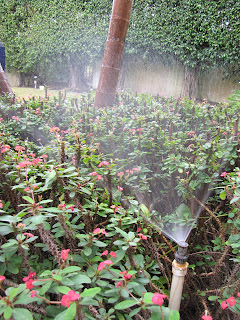
Phase I: the dirty dirty
The dirty portion of the installation involves drilling holes for the access tubes that encase the soil water sensor probes and then properly cementing the tubes in place.




Under different circumstances, holes for these probes can be achieved with a simple core tool, and the tubes are then fixed in place with a soil slurry.

In South Florida’s rocky terrain, however, a drill and fine cement is the preferred method.





Once the tubes were cemented in place, exposed portions were painted and existing protective barriers surrounding research equipment were adjusted to encompass the new probe locations.




Phase II: the clean
The clean portion of the installation takes place once the access tubes are fixed in place. Soil water sensor probe head units (power source) are mounted, probes are inserted into access tubes and wired and then launched to begin data collection.




Phase III: establishment
Although structural problems in the probe installation (air pockets, etc.) sometimes present themselves months after installation, basic weaknesses in the drilling and cementing process can be readily identified once data collection begins. Where data inconsistencies are apparent and irreconcilable, the installation process must be repeated from the beginning.

Acknowledgments:
Isaya would like to thank the following people for their help during the new EnviroSCAN installation at C-111 on January 20, 2011.
Dr .Kati W. Migliaccio: Thank you very much for the exceptional guidance and support
Dr. Bruce Schaffer: Thank you for providing the knowledge, skill and as well as your experience during the installation
Michael Gutierrez: Thank you teaching me from scratch about EviroScans from assembly, configuration, installation and downloading
Tina Dispenza: Thank you for your support and guidance. Your experience will make the difference on this project
Tereza P. Cristina: Thank you for taking off time from your busy schedule to help with the installation of the EnviroScan. Having extra hands made the job much easier.
Chunfang Li (Daisy): Thank you very much for all the support you have given to the C-111 project from downloading of data to installations.
The dirty portion of the installation involves drilling holes for the access tubes that encase the soil water sensor probes and then properly cementing the tubes in place.




Under different circumstances, holes for these probes can be achieved with a simple core tool, and the tubes are then fixed in place with a soil slurry.

In South Florida’s rocky terrain, however, a drill and fine cement is the preferred method.





Once the tubes were cemented in place, exposed portions were painted and existing protective barriers surrounding research equipment were adjusted to encompass the new probe locations.




Phase II: the clean
The clean portion of the installation takes place once the access tubes are fixed in place. Soil water sensor probe head units (power source) are mounted, probes are inserted into access tubes and wired and then launched to begin data collection.




Although structural problems in the probe installation (air pockets, etc.) sometimes present themselves months after installation, basic weaknesses in the drilling and cementing process can be readily identified once data collection begins. Where data inconsistencies are apparent and irreconcilable, the installation process must be repeated from the beginning.

Acknowledgments:
Isaya would like to thank the following people for their help during the new EnviroSCAN installation at C-111 on January 20, 2011.
Dr .Kati W. Migliaccio: Thank you very much for the exceptional guidance and support
Dr. Bruce Schaffer: Thank you for providing the knowledge, skill and as well as your experience during the installation
Michael Gutierrez: Thank you teaching me from scratch about EviroScans from assembly, configuration, installation and downloading
Tina Dispenza: Thank you for your support and guidance. Your experience will make the difference on this project
Tereza P. Cristina: Thank you for taking off time from your busy schedule to help with the installation of the EnviroScan. Having extra hands made the job much easier.
Chunfang Li (Daisy): Thank you very much for all the support you have given to the C-111 project from downloading of data to installations.




















